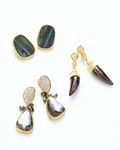08 Oct Telluride’s Dolce introduces Birthstone of the Month: Opals
 Editor's note: The astrological signs of October are Libra (September 23 –October 22) and Scorpio (October 23 – November 21). For what's happening in the stars, see Cynthia Zehm's weekly Alacazem. But celestial bodies are not all that shines: the birthstone of the month is opal. To romance the stone, see Telluride Inside… and Out's newest monthly column, Birthstones, from Dolce.
Editor's note: The astrological signs of October are Libra (September 23 –October 22) and Scorpio (October 23 – November 21). For what's happening in the stars, see Cynthia Zehm's weekly Alacazem. But celestial bodies are not all that shines: the birthstone of the month is opal. To romance the stone, see Telluride Inside… and Out's newest monthly column, Birthstones, from Dolce.
It is altogether fitting and proper that our birthstone column launches with a riff on opals because Dolce's owner and Telluride local Beau Staley has a personal history with the stone.
In 1989, Beau spent his summer break from college working for Nagalle Designs, a company founded and run by Dolce artist, sculptor James Vilona and once a dominant force in inlaid jewelry manufacturing. Nagalle built its fine reputation on its designs incorporating the coveted Australian opal. Beau wound up taking over Nagalle from James so that James could work full time on his art. By the time Beau sold Nagalle hinself, he had built a reputation as a power player in the wholesale marketing of this precious stone.
 The word "opal" comes from various roots: Sanskrit "upala" meaning precious stone; Greek, "opallos," meaning to observe color change; and Latin, "opalus," meaning "seeing jewel."
The word "opal" comes from various roots: Sanskrit "upala" meaning precious stone; Greek, "opallos," meaning to observe color change; and Latin, "opalus," meaning "seeing jewel."
Myths and superstitions about opals go back in time and across the globe.
Australian Aborigines named the gem "Rainbow Serpent," and told the story about the Creator traveling across the world, using a rainbow as his road, to spread a message of peace. With each step, the stones under his feet turned into miniature, tangible rainbows. In other words, they transformed into opals. The Greeks claim Zeus was so jazzed when he defeated the Titans, he wept tears of joy that turned into opals when they hit the ground. In a desperate attempt to flee the male gods who relentlessly pursued her, the Indian goddess of the rainbow transformed herself into an opal, the rainbow stone. Greeks believed the opal conferred gifts of foresight and prophecy on the wearer.
During the MIddle Ages, the opal was known as "ophthalmios" (from the Greek ) due to a widespread belief that wearing the stone was beneficial to the eyes. Blond women wore opal necklaces to protect their hair from losing its color.
And so on…
Although once mined exclusively in Hungary, today's opals generally come from Australia and Mexico, found in the seams of volcanic rock into which they originally formed as part of a boiling silica-water solution. Once deposited in rock crevices, the solution cooled or "opalized" into its hardened form. The play of color, a signature of opals, is a function of these dense spheres of silica.
Opals occur in a range of colors: white, pale yellow, pale red, light blue, brown, gray, and black. The stone has a pearly luster ranging from transparent to opaque. The natural brittleness of opals means they can be easily splintered or fractured during cutting. In general, opals are very fragile, sensitive to light, air and temperature. Which means the stone is as unpredictable as the women who wear them. When cleaning opals, it is important to use only soap and water. Chemicals or ultrasonic devices cause cracking and loss of luster.
Check out the way Dolce designer Katey Brunini incorporates opals into her designs: mixed metals play into the variety of colors of the gemstone.


Sorry, the comment form is closed at this time.